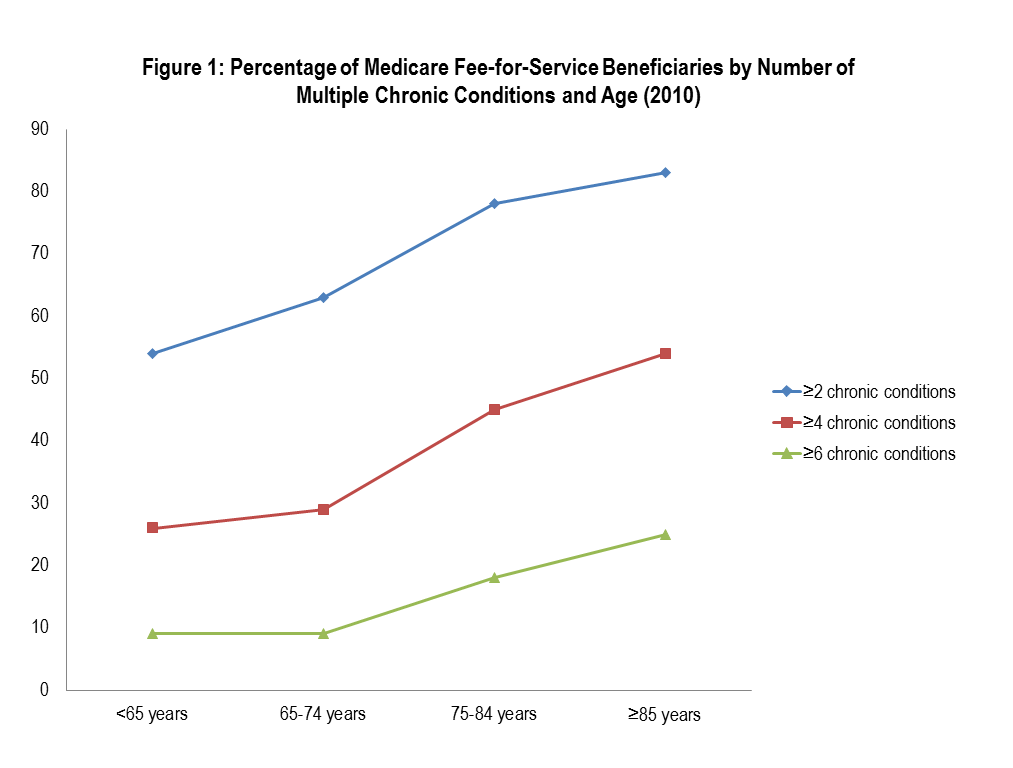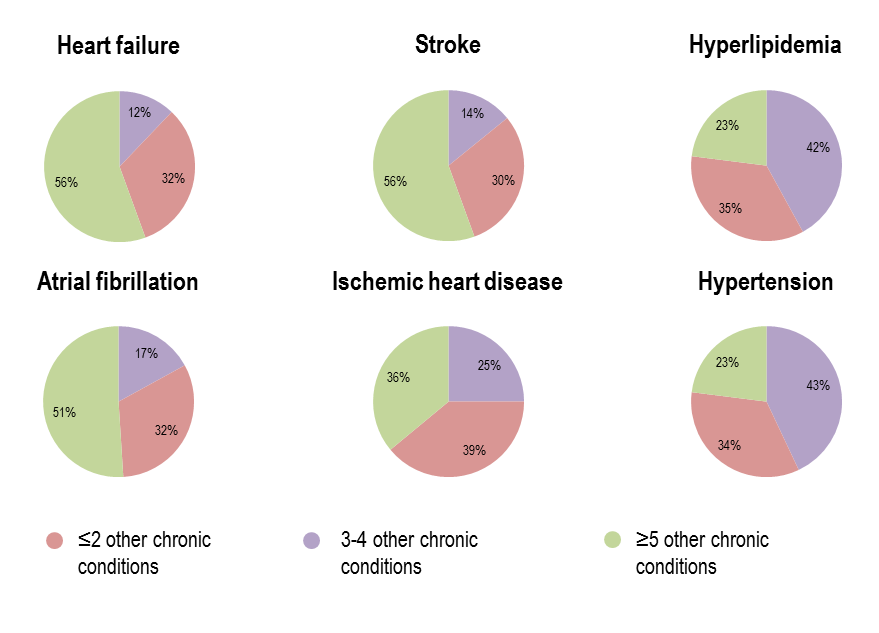Multimorbidity in Older Adults With Cardiovascular Disease
Multimorbidity, defined as the presence of two or more chronic conditions, affects more than two-thirds of Americans ≥65 years of age, and the prevalence exceeds 80% among those ≥75 years of age (Figure 1).1,2 Moreover, half of adults 75 years of age or older have four or more chronic conditions, and over 20% have six or more coexisting illnesses.1
Figure 1
Not surprisingly, multimorbidity is associated with impaired quality of life, increased risk for disability, institutionalization, and mortality, and higher health care utilization and associated costs.3 For example, the annual risk for hospitalization increases from 4% among individuals with zero to one chronic conditions to more than 60% in those with six or more chronic conditions.1 Further, 30-day readmission rates increase progressively as the number of chronic conditions rises, and per capita Medicare expenditures increase exponentially as a function of the number of chronic conditions (Figure 2).2
Figure 2
Increasing age is a potent risk factor for cardiovascular disease (CVD), and more than 75% of men and women 75 years of age or older have manifest CVD.4 As a result, CV disorders frequently contribute to multimorbidity, and, conversely, older adults with CVD have a high prevalence of multimorbidity.1,5 For example, among Medicare beneficiaries with heart failure (HF) or atrial fibrillation, more than 50% have five or more additional chronic conditions (Figure 3).1,5
Figure 3
From the clinical perspective, the presence of multimorbidity has substantial implications for management of older adults with CVD (Table 1). First, practice guidelines for CVD are based on randomized trials that largely excluded older adults with multiple chronic conditions, especially those with cognitive impairment, frailty, or residence in a nursing home.6 Second, simultaneous application of recommendations from multiple guidelines to address concurrent conditions may not be feasible due to time and cost constraints, and in some cases may compromise patient safety (e.g., use of non-steroidal anti-inflammatory drugs to treat arthritis in patients with comorbid HF or renal disease).5,7 Third, multimorbidity greatly increases therapeutic complexity and polypharmacy with associated risks for medication-related adverse events due to drug-drug and drug-disease interactions. Fourth, functional impairments and shortened life-expectancy may attenuate or even eliminate the benefits of therapeutic interventions. For example, coronary revascularization is unlikely to improve quality of life and may not increase length of life in a patient with severe Parkinson's disease. Finally, while patient preferences should always play a central role in clinical decision-making, as the burden of comorbidities escalates it becomes increasingly important to elicit each patient's goals of care and to align therapy with the patient's stated wishes in order to achieve the desired outcomes. In essence, this means moving away from the largely disease-centric care promulgated by guidelines and towards more holistic care that acknowledges that CVD is only one facet of a person's overall health state, and possibly not the most important facet from the patient's perspective.
Table 1: Implications of Multimorbidity for Management of Older Adults with CVD
|
Approach to Managing CVD in the Context of Multimorbidity
Optimal management of older adults with CVD complicated by multimorbidity requires close collaboration between primary care providers, cardiologists, other subspecialists, and geriatricians, as well as nurses, dieticians, pharmacists, therapists, and social service personnel. In addition, the American Geriatrics Society has published guiding principles for managing older adults with multimorbidity (Table 2).8
Table 2: Guiding Principles for Managing Older Adults with Multimorbidity
|
Elicitation of patient preferences begins with a discussion of the clinical condition (e.g., coronary artery disease), diagnostic and therapeutic options and their attendant risks, and the likely impact of these interventions on relevant health outcomes, such as quality of life, maintenance of independence, and survival. In general it is desirable to frame these discussions in the context of the patient's broader healthcare goals (i.e., outcomes of highest priority), acknowledging that there may be trade-offs (e.g., sacrificing length of life to maximize quality of life or vice-versa). When feasible, family and other surrogates should be involved in these discussions, especially in patients with cognitive impairment.
Interpreting the evidence involves determining to what extent available data are applicable to older adults with multimorbidity. Assessment of absolute risk reduction (e.g., number-needed-to-treat) and potential for adverse events (number-needed-to-harm) is more useful than evaluation of relative risks or odds ratios, which can be misleading. In addition, the time horizon of benefits and risks should be examined in the context of the patient's overall prognosis, since harms often occur early (e.g., at the time of a procedure), whereas benefits may be delayed.
Overall prognosis, including remaining years of life and remaining years with acceptable quality of life, as well as condition-specific prognosis (e.g., risk of stroke in atrial fibrillation) must be considered in deciding how aggressively to pursue diagnostic and therapeutic interventions. Although prognosis is often difficult to assess accurately, validated tools are available for estimating survival (eprognosis.ucsf.edu) and dependency-free survival.9,10 In addition, the Clinical Frailty Score is a simple metric that correlates with survival and avoidance of institutionalization.11
Treatment complexity and feasibility, including both lifestyle interventions (e.g., dietary modifications, exercise) and medications should also be considered in light of the patient's functional and cognitive limitations, social support, economic resources, and personal preferences. The medication regimen should be as simple as possible and all non-essential drugs should be discontinued. Potential barriers to medication adherence and implementation of lifestyle changes should be elicited and addressed.
Successful negotiation of the above principles will facilitate selection of those interventions with the greatest likelihood of achieving the desired health outcomes at a projected level of risk that is acceptable to the patient. Nonetheless, additional discussion may be needed before finalizing the management plan, and ongoing discussions will inevitably be required as clinical and personal circumstances evolve. Moreover, since patient preferences and goals of care often change, especially as prognosis worsens and death approaches, this is an inherently iterative process.
Addressing the Challenge to Caring for Older Adults with Multimorbidity
As the population ages, the number of older adults with multimorbidity will continue to increase and the individual, societal, economic, and healthcare burden of this relatively recent phenomenon will continue to grow. To address this challenge, numerous organizations, including the American College of Cardiology (ACC), American Heart Association, American Geriatrics Society, National Institute on Aging (NIA), Center for Medicare and Medicaid Services, Food and Drug Administration, and Patient-Centered Outcomes Research Institute, just to name a few, have devoted considerable resources to developing effective strategies for optimizing care of this population and to fostering research that will advance knowledge and improve the evidence base for managing older adults with multimorbidity. In this regard, the ACC's Geriatric Cardiology Section was privileged to host a one-and-a-half day workshop entitled "Multimorbidity in Older Adults with CVD" on February 9-10, 2015 at ACC's Heart House. This workshop, which was supported by a grant from NIA (U13 AG47008) and several industry partners, brought together leading cardiologists, geriatricians, nurses, and other key stakeholders to review current knowledge and to develop a research agenda to address knowledge gaps in this area. Additional information about the workshop is available at www.accagsniamultimorbidityworkshop.com, and a compilation of articles based on the workshop has recently been published.12
Additional Resources
- U.S. Department of Health and Human Services. HHS Initiative on Multiple Chronic Conditions. 2014. Available at: http://www.hhs.gov/ash/initiatives/mcc/. Accessed July 26, 2016.
- U.S. Department of Health and Human Services. Multiple Chronic Conditions – A Strategic Framework: Optimum Health and Quality of Life for Individuals with Multiple Chronic Conditions. Available at: http://www.hhs.gov/sites/default/files/ash/initiatives/mcc/mcc_framework.pdf. Accessed July 26, 2016.
- Montori VM, Brito JP, Murad MH. The optimal practice of evidence-based medicine incorporating patient preferences in practice guidelines. JAMA 2013;310:2503-4.
- Jadad AR, To MJ, Emara M, Jones J. Consideration of multiple chronic diseases in randomized controlled trials. JAMA 2011;306:2670-2.
- Boyd CM, Vollenweider D, Puhan MA. Informing evidence-based decision-making for patients with comorbidity: availability of necessary information in clinical trials for chronic diseases. PLoS One 2012;7:e41601.
References
- Centers for Medicare and Medicaid Services. Chronic Conditions among Medicare Beneficiaries, Chartbook, 2012 Edition. Baltimore, MD: 2012. Available at: https://www.cms.gov/research-statistics-data-and-systems/statistics-trends-and-reports/chronic-conditions/downloads/2012chartbook.pdf. Accessed July 26, 2016.
- Centers for Medicare & Medicaid Services. Chronic conditions overview. 2014. Available at: http://www.cms.gov/Research-Statistics-Data-and-Systems/Statistics-Trends-and-Reports/Chronic-Conditions/index.html. Accessed July 26, 2016.
- Kim DH, Rich MW. Patient-centred care of older adults with cardiovascular disease and multiple chronic conditions. Can J Cardiol 2016;32:1097-107.
- Mozaffarian D, Benjamin EJ, Go AS, et al. Executive summary: heart disease and stroke statistics – 2016 update: a report from the American Heart Association. Circulation 2016:133:447-54.
- Arnett DK, Goodman RA, Halperin JL, Anderson JL, Parekh AK, Zoghbi WA. AHA/ACC/HHS strategies to enhance application of clinical practice guidelines in patients with cardiovascular disease and comorbid conditions: from the American Heart Association, American College of Cardiology, and U.S. Department of Health and Human Services. J Am Coll Cardiol 2014;64:1851-6.
- Rich MW, Chyun DA, Skolnick AH, et al. Knowledge gaps in cardiovascular care of the older adult population: a scientific statement from the American Heart Association, American College of Cardiology, and American Geriatrics Society. J Am Coll Cardiol 2016;67:2419-40.
- Boyd CM, Darer J, Boult C, Fried LP, Boult L, Wu AW. Clinical practice guidelines and quality of care for older patients with multiple comorbid diseases: implications for pay for performance. JAMA 2005;294:716-24.
- American Geriatrics Society Expert Panel on the Care of Older Adults with Multimorbidity. Guiding principles for the care of older adults with multimorbidity: an approach for clinicians. J Am Geriatr Soc 2012;60:e1-25.
- Yourman LC, Lee SJ, Schonberg MA, Widera EW, Smith AK. Prognostic indices for older adults: a systematic review. JAMA 2012;307:182-92.
- Covinsky KE, Hilton J, Lindquist K, Dudley RA. Development and validation of an index to predict activity of daily living dependence in community-dwelling elders. Med Care 2006;44:149-57.
- Rockwood K, Song X, MacKnight C, et al. A global clinical measure of fitness and frailty in elderly people. CMAJ 2005;173:489-95.
- Rich MW, Boyd C, Picala JT (eds). Managing chronic conditions in older adults with cardiovascular disease. Clin Geriatr Med 2016;32:215-414.
Keywords: Arthritis, Atrial Fibrillation, Cognition, Cognition Disorders, Comorbidity, Coronary Artery Disease, Geriatrics, Heart Failure, Medication Adherence, Nursing Homes, Parkinson Disease, Patient Care Planning, Patient Outcome Assessment, Patient Safety, Polypharmacy, Primary Health Care, Quality of Life, Risk Assessment, Risk Factors, Stroke
< Back to Listings



